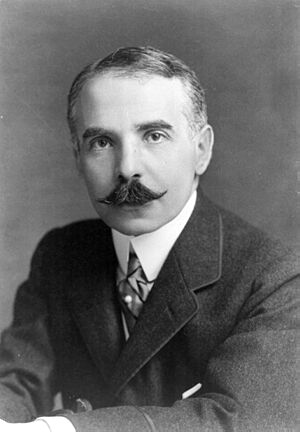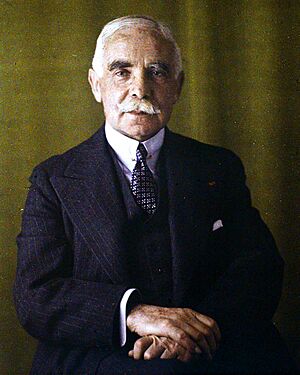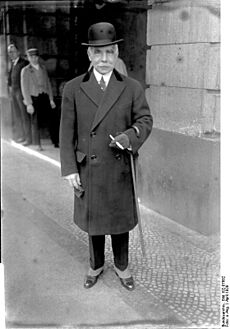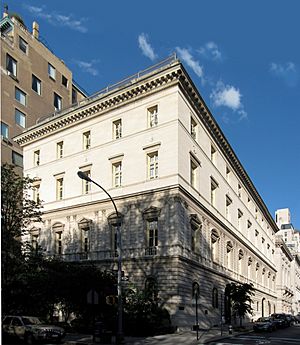Otto Hermann Kahn facts for kids
Quick facts for kids
Otto Hermann Kahn
|
|
|---|---|

Kahn in 1909
|
|
| Born | February 21, 1867 |
| Died | March 29, 1934 (aged 67) New York City, United States
|
| Resting place | St. John's Memorial Cemetery, Laurel Hollow, New York |
| Occupation | Banker |
| Employer | Kuhn, Loeb & Co. |
| Spouse(s) | Addie Wolff (m. 1896) |
| Children | 4, including Roger |
| Relatives | Virginia Ogilvy, Countess of Airlie (granddaughter) |
| Signature | |
 |
|
Otto Hermann Kahn (born February 21, 1867 – died March 29, 1934) was an important American banker, who was born in Germany. He was also a collector, a generous giver to charity (a philanthropist), and a big supporter of the arts. Many people knew Otto Kahn. He even appeared on the cover of Time magazine and some called him the "King of New York".
In business, he was famous for being a partner at Kuhn, Loeb & Co.. He helped reorganize and combine many railroads. In his personal life, he loved and supported the arts. He was even the chairman of the Metropolitan Opera.
Contents
Otto Kahn's Early Life and Career
Otto Kahn was born on February 21, 1867, in Mannheim, Germany. His parents, Emma and Bernard Kahn, raised him there. His father had lived in the United States for a time.
Otto went to a special school called a gymnasium in Mannheim. He dreamed of becoming a musician and learned to play several instruments. However, his father had different plans for his eight children.
Starting in Banking
At 17, Otto began working as a junior clerk at a bank in Karlsruhe. He worked there for three years. During this time, he learned a lot about how money and finance work. After that, he served for one year in the Kaiser's army.
After leaving the army, he went to work for the Deutsche Bank in London. He stayed there for five years. He was so talented that he quickly became the second-in-command. He liked the English way of life and later became a British citizen.
In 1893, he moved to the United States to work for Speyer and Company in New York. He lived there for the rest of his life. On January 8, 1896, Otto married Addie Wolff. After a year-long trip to Europe, Kahn joined Kuhn, Loeb & Co. in New York City. His father-in-law, Abraham Wolff, was a partner there. In 1917, Kahn became a citizen of the United States.
Reorganizing Railroads
At Kuhn, Loeb & Co., Kahn worked closely with the famous railroad builder E. H. Harriman. Even though they were very different, they became like brothers. Harriman was tough and aggressive in business. Kahn was calm, kind, and gentle.
Even at just 30 years old, Kahn played a big part in fixing the Union Pacific Railroad. He was very good at using math and science to solve problems. Soon, people recognized him as the best railroad reorganizer in the United States.
He worked on many other railroads, including the Baltimore and Ohio Railroad and the Missouri Pacific Railroad. His quick actions often stopped financial problems from getting worse. For example, he saved a group of investors who were trying to combine several South American railroads.
International Finance

Kahn also helped open the Paris Bourse (the French stock exchange) to American investments. In 1906, $50 million in Pennsylvania bonds were officially listed there. This was the first time American investments were officially listed in Paris. He also helped Kuhn, Loeb and Company issue bonds for the City of Paris and other French cities.
In 1933, Kahn spoke to the United States Senate during hearings about the Wall Street Crash of 1929. He was very smooth and polite. He helped explain how private bankers worked in a positive way.
Otto Kahn was also a trustee at the Massachusetts Institute of Technology and Rutgers College. He was on the board of many companies, like the Equitable Trust Co. and the Union Pacific Railroad.
Later Years and Death
In his last years, Kahn became weaker. He had heart problems and high blood pressure. On March 29, 1934, after lunch at his office, Kahn had a major heart attack and died at age 67. His funeral was held at his home on Long Island. He was buried in St. John's Memorial Cemetery.
Otto Kahn: A Patron of the Arts
Otto Kahn was a very rich banker. He used his wealth to support the arts. He was the president and chairman of the board for the Metropolitan Opera. He was also the vice-president of the New York Philharmonic. He helped many artists, including George Gershwin and Arturo Toscanini.
He also loved Hollywood. His company, Kuhn Loeb, provided a lot of money to the film industry. Kahn even gave personal support to Hollywood. The famous singer Fanny Brice mentioned him in a song, joking about how he might have missed her talent.
Kahn was also made fun of as the character Roscoe W. Chandler in the Marx Brothers' show Animal Crackers.
He was the chairman of the New York committee for the Shakespeare Tercentenary in 1916. He was also a founder and treasurer of the New Theatre Company.
Otto's son, Roger Wolfe Kahn, became a popular jazz musician and bandleader. His daughter, Margaret, was a well-known person in New York society and also supported the Metropolitan Opera.
Some people used to think that the famous "Rich Uncle Pennybags" character from the Monopoly board game looked like Otto Kahn. However, the family of the artist who created the character later said that J. P. Morgan was the real inspiration.
Otto Kahn's Homes and Buildings

Like many wealthy men of his time, Kahn had a home in New York City and a country estate. His first country home, Cedar Grove, was in Morristown, New Jersey. Even though he lived there for years, he wasn't fully accepted by the local society. This led him to move to Long Island.
Oheka Castle: Long Island Estate
By 1919, Kahn owned a 443-acre estate on Long Island. He built a huge mansion there called Oheka Castle. The name "Oheka" comes from Otto Hermann Kahn.
This 127-room house was designed to be the second-largest private home in the United States. It was 109,000 square feet! The estate had a golf course, a working farm, a private airstrip, and many other buildings.
After Kahn died in 1934, the property was sold. It was used as a retreat for sanitation workers and then a training school. Later, a housing development was built there. In 1948, a military school bought the mansion.
By the time the school closed, the gardens were gone, and the rooms were changed. Vandals tried to burn the building many times. But because Kahn had built it with strong concrete, brick, and steel, the house survived. In 1984, a developer named Gary Melius bought the estate. He started the biggest private renovation project ever in the United States. Today, Oheka Castle is used for events, as a hotel, and a conference center.
New York City Mansion
In 1913, Kahn bought a property at 1 East 91st Street in New York City. He hired architects to design his city mansion. This 80-room home was built in the Italian Renaissance style. It was finished in 1918 and was Kahn's New York City home until he died.
Soon after his death, the house was sold to the Convent of the Sacred Heart, a girls' school. In 1974, the house became a protected landmark in New York City.
Palm Beach Homes
Kahn also built a summer home in Palm Beach, Florida, which he also named "Oheka". When that house was too small, he built another "Oheka" nearby. After he died, this house was used as a school. Later, it was bought by a businessman and became a private home again.
Otto Kahn's Boat: Oheka II
In 1927, Kahn asked a German boat builder named Lürssen to build him a very fast motor yacht. He wanted to use it on the Rhine river and in the North Sea. This boat, called Oheka II, was very special.
It had a unique design and three powerful engines. This made it incredibly fast, reaching 34 knots (about 39 miles per hour). It was the fastest boat in its class at the time. The German Navy noticed Oheka II's speed. This helped them develop their own fast torpedo boats, called Schnellboots.
Otto Kahn's Family Life
Otto's father, Bernhard Kahn, was a German-Jewish industrialist and banker. He was involved in the Revolutions of 1848 and had to escape to the United States. He became an American citizen but later returned to Germany. He married Emma Stephanie Eberstadt in 1860. They had eight children, and Otto was the third son.
Otto married Adelaide Wolff on January 8, 1896. They had four children: Maud, Margaret, Gilbert, and Roger Wolff Kahn. Margaret's daughter, Virginia Ryan, later became Virginia Ogilvy, Countess of Airlie.
Kahn was buried in the St. John's Memorial Cemetery in Laurel Hollow, New York.
Books and Speeches by Otto Kahn
Otto Kahn wrote many books and gave speeches on various topics, including finance, art, and public affairs. Some of his works include:
- Edward Henry Harriman: An address delivered before the Finance Forum in New York on January 25, 1911 (1911)
- Art and the People (1916)
- High Finance (1916)
- The War and Business (1917)
- Right Above Race (1918)
- The Menace of Paternalism (1918)
- Our Economic and Other Problems: A Financier's Point of View (1920)
- Reflections of a Financier: A Study of Economic and Other Problems (1921)
- The Value of Art to the People (1924)
- Of Many Things: Being Reflections and Impressions on International Affairs, Domestic Topics and the Arts (1926)
Images for kids
See also
- Kahn Lectures
- List of covers of Time magazine (1920s)







